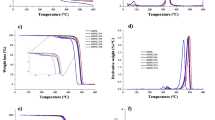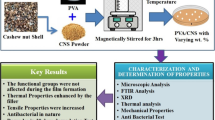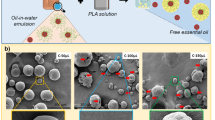Abstract
Post-consumer PET (rPET) has become a worldwide concern due to the huge waste accumulation. Therefore, it is necessary to explore processing methods to recycle or reuse rPET to save resources and contribute to solving environment-related issues. Furthermore, the addition of inclusion complexes in the rPET matrix increases its application in terms of the release of active compounds that improve the added value of the polymer. Thus, active rPET films with thyme and orange essential oils were prepared by compression molding or extrusion. The effect of the different processing methods, as well as reprocessing, on the structural, mechanical, and antifungal properties of the active films was assessed. The results show that compression molding is not a suitable method to produce active films since their operation conditions, such as residence time and temperature, triggered the decomposition of the inclusion complex (IC), negatively affecting the appearance and mechanical properties (brittle and fragile) of films. Conversely, the extrusion process allowed preserving the IC and dispersing them adequately within the rPET matrix, maintaining the mechanical integrity of the films and resulting in a high antifungal activity against the growth of Penicillium funiculosum hyphae. This behavior was also observed after the re-extrusion process, corroborating that extrusion is a suitable method to process the active rPET films more than once without the detriment of their mechanical and antifungal properties.






Similar content being viewed by others
References
Aragão AA, Figueiredo LRF, Santos ASF, Medeiros ES (2023) Influence of the addition of glycerol-derived polymers on the properties of post-consumer recycled PET. https://doi.org/10.21203/rs.3.rs-3030693/v1
Laldinpuii ZT, Khiangte V, Lalhmangaihzuala S et al (2022) Methanolysis of PET Waste using Heterogeneous Catalyst of Bio-waste Origin. J Polym Environ 30:1600–1614. https://doi.org/10.1007/s10924-021-02305-0
Wang D, Yang B, Chen QT et al (2019) A facile evaluation on melt crystallization kinetics and thermal properties of low-density polyethylene (LDPE)/Recycled polyethylene terephthalate (RPET) blends. Adv Industrial Eng Polym Res 2:126–135. https://doi.org/10.1016/j.aiepr.2019.05.002
Welle F (2011) Twenty years of PET bottle to bottle recycling - an overview. Resour Conserv Recycl 55:865–875
Junqueira-Gonçalves MP, Alarcón E, Niranjan K (2014) Post-consumer recycled PET packaging for Fresh berries: a comparative study between incorporating an Antifungal Agent superficially and into the main body of the packaging. Food Bioproc Tech 7:2610–2617. https://doi.org/10.1007/s11947-014-1262-5
Velázquez-Contreras F, Zamora-Ledezma C, López-González I et al (2022) Cyclodextrins in polymer-based active food packaging: a fresh look at nontoxic, biodegradable, and sustainable technology trends. Polym (Basel) 14
Westlake JR, Tran MW, Jiang Y et al (2023) Biodegradable biopolymers for active packaging: demand, development and directions. Sustainable Food Technology 1:50–72. https://doi.org/10.1039/d2fb00004k
Uranga J, Etxabide A, Guerrero P, de la Caba K (2018) Development of active fish gelatin films with anthocyanins by compression molding. Food Hydrocoll 84:313–320. https://doi.org/10.1016/j.foodhyd.2018.06.018
Dumont P, Martoïa F, Orgéas L (2023) Compression moulding. Design and manufacture of Structural composites. Elsevier, pp 273–300
Ceballos RL, von Bilderling C, Guz L et al (2021) Effect of greenly synthetized silver nanoparticles on the properties of active starch films obtained by extrusion and compression molding. Carbohydr Polym 261. https://doi.org/10.1016/j.carbpol.2021.117871
Azevedo AG, Barros C, Miranda S et al (2022) Active Flexible Films for Food Packaging: A Review. Polymers (Basel) 14
Kaewpetch T, Pratummang A, Suwarak S et al (2023) Ylang-Ylang (Cananga odorata) essential oils with flora odorants enhanced active function of biodegradable polyester films produced by extrusion. Food Biosci 51. https://doi.org/10.1016/j.fbio.2022.102284
Dong Z, Xu F, Ahmed I et al (2018) Characterization and preservation performance of active polyethylene films containing rosemary and cinnamon essential oils for Pacific white shrimp packaging. Food Control 92:37–46. https://doi.org/10.1016/j.foodcont.2018.04.052
Paiva-Santos AC, Ferreira L, Peixoto D et al (2022) Cyclodextrins as an encapsulation molecular strategy for volatile organic compounds— Pharmaceutical applications. Colloids Surf B Biointerfaces 218
Flores-Silva PC, Hernández-Hernández E, Sifuentes-Nieves I et al (2023) Active Mono-Material films from Natural and Post‐consumer recycled polymers with essential oils for Food Packaging Applications. J Polym Environ. https://doi.org/10.1007/s10924-023-02943-6
Bae HJ, Park HJ, Darby DO et al (2009) Development and characterization of PET/Fish gelatin-nanoclay composite/LDPE laminate. Packaging Technol Sci 22:371–383. https://doi.org/10.1002/pts.845
Das P, Tiwari P (2019) Thermal degradation study of waste polyethylene terephthalate (PET) under inert and oxidative environments. Thermochim Acta. https://doi.org/10.1016/j.tca.2019.178340. 679:
Belioka MP, Markozanne G, Chrissopoulou K, Achilias DS (2023) Advanced Plastic Waste Recycling—the Effect of Clay on the morphological and thermal behavior of recycled PET/PLA sustainable blends. Polym (Basel) 15. https://doi.org/10.3390/polym15143145
Zhang XH, Jiao MX, Wang X et al (2022) Preheat Compression Molding for Polyetherketoneketone: Effect of Molecular Mobility. Chin J Polym Sci (English Edition) 40:175–184. https://doi.org/10.1007/s10118-021-2649-1
Šudomová L, Doležalová Weissmannová H, Steinmetz Z et al (2023) A differential scanning calorimetry (DSC) approach for assessing the quality of polyethylene terephthalate (PET) waste for physical recycling: a proof-of-concept study. J Therm Anal Calorim. https://doi.org/10.1007/s10973-023-12430-8
Mysiukiewicz O, Barczewski M (2020) Crystallization of polylactide-based green composites filled with oil-rich waste fillers. J Polym Res. https://doi.org/10.1007/s10965-020-02337-5. 27:
Ronkay F, Molnár B, Nagy D et al (2020) Melting temperature versus crystallinity: new way for identification and analysis of multiple endotherms of poly(ethylene terephthalate). J Polym Res 27. https://doi.org/10.1007/s10965-020-02327-7
Chen C, Li C, Yang S et al (2019) Development of New Multilayer active packaging films with controlled release property based on Polypropylene/Poly(Vinyl Alcohol)/Polypropylene Incorporated with Tea Polyphenols. J Food Sci 84:1836–1843. https://doi.org/10.1111/1750-3841.14681
Pandey S, Sharma K, Gundabala V (2022) Antimicrobial bio-inspired active packaging materials for shelf life and safety development: a review. Food Biosci 48
Magalhães Brandão R, Roberto Batista L, Elvis de Oliveira J et al (2023) In vitro and in vivo efficacy of poly(lactic acid) nanofiber packaging containing essential oils from Ocimum basilicum L. and Ocimum gratissimum L. against Aspergillus Carbonarius and Aspergillus Niger in table grapes. Food Chem 400. https://doi.org/10.1016/j.foodchem.2022.134087
Acknowledgements
We want to thank R. Cedillo-García, M. Salinas- Hernández, G. Mendez-Padilla, J.F. Lara-Sánchez, J.A. Cepeda-Garza, C.N. Alvarado-Canché, M. Lozano-Estrada and J.A. Mercado-Silva for their technical assistance. We also thank the Laboratorio Nacional de Materiales Grafénicos (LNMG) for the facility in the use of characterization equipment through the CONAHCYT project 321244.
Funding
The authors are thankful for the partial financial support provided by the Laboratorio Nacional en Innovación y Desarrollo de Materiales Ligeros para la Industria Automotriz (LANIAUTO) through the CONAHCYT Project 321156. Also, author Flores-Silva Pamela C acknowledges the postdoctoral fellowship from CONAHCYT, Mexico.
Author information
Authors and Affiliations
Contributions
Pamela C. Flores-Silva: Supervision, Original draft, Writing- Reviewing and Editing; Gisela Aguilar-Padilla: Methodology; Israel Sifuentes-Nieves: Writing - review & editing; Pablo Gonzáles-Morones: Methodology; Antonio Ledezma-Pérez: Investigation; Ernesto Hernández-Hernández: Investigation, Data curation; Eduardo Ramírez-Vargas: Conceptualization, Writing- Reviewing and Editing.
Corresponding authors
Ethics declarations
Competing Interests
The authors declare no competing interests.
Conflict of Interest
The authors have declared no conflicts of interest.
Additional information
Publisher’s Note
Springer Nature remains neutral with regard to jurisdictional claims in published maps and institutional affiliations.
Rights and permissions
Springer Nature or its licensor (e.g. a society or other partner) holds exclusive rights to this article under a publishing agreement with the author(s) or other rightsholder(s); author self-archiving of the accepted manuscript version of this article is solely governed by the terms of such publishing agreement and applicable law.
About this article
Cite this article
Flores-Silva, P., Aguilar-Padilla, G., Sifuentes-Nieves, I. et al. Post-consumer Recycled PET Active Films Containing β-Cyclodextrins-Based Inclusion Complexes with Essential Oils: A Comparative Study between Processing Methodologies. J Polym Environ (2023). https://doi.org/10.1007/s10924-023-03147-8
Accepted:
Published:
DOI: https://doi.org/10.1007/s10924-023-03147-8




